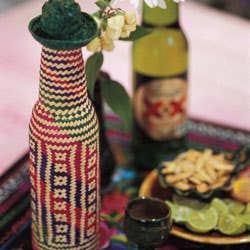
Mescal Demystified
There is a misconception in America that mescal is some sort of deadly firewater, or an inferior variation of tequila. In fact, mescal can achieve great subtlety of flavor; it's a kind of Mexican eau-de-vie.
In the state of Oaxaca, mescal is still produced by pre-industrial, artisanal methods. The hearts of maguey cactus plants are roasted in pits layered with rocks. After sitting for five days—to allow the starch to turn into sugar—they are mashed under horse-powered stone grinding-wheels and left to ferment. Afterwards the mash is distilled over fires in copper or clay stills, the condensation running down agave threads into glass jars, to be drawn off into smaller bottles—often covered with decorative woven straw sleeves—as needed.
Mescal is frequently flavored with herbs—everybody seems to have a recipe—and sometimes with other things: assorted fruit, spices, almonds, even a whole raw chicken (!)—definitely an acquired taste. And what about the famous, daunting worm found in some bottles of mescal? Sometimes it's added simply to enhance the flavor of mescals lacking character of their own. But for the complete experience, follow a shot of mescal with a lick of baked worms, ground up with chiles and salt.
Keep Reading
Continue to Next Story










